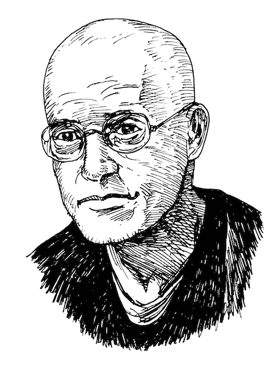In his studio, Chris Martin and his two assistants peruse a leaning stack of his finished, mural-sized paintings. The canvases are as tall as the ceiling and as wide as the walls—they sometimes reach thirty feet in height—and it takes all three people to lift and slide them around the room. When finished, he is surrounded by a room of head-tilting, periphery-filling images and lit by the skylight above.
Martin laughs when he sees the older pieces that have been covered for years, some of which he can’t recall making. He leans against a pair of conga drums that he plays while giving lectures to art students. He teaches often and was an art therapist for many years, but his love of painting seems to be in spite of his distaste for contemporary art institutions. His work reflects this stance: it is unconcerned with trends or stylistic consistency or dictums about art, and its most glaring influences seem to come from artists outside of the art world—so-called vernacular artists.
Martin paints what he wants to paint, without post-modern complications. His art is direct. He sometimes pays homage to important figures in his life—Harry Smith, Paul Thek, Alfred Jensen, Bill Jensen, James Brown—by slathering their names on the image. He paints on records, slices of white bread, pillows, aluminum foil, and uses copious amounts of glitter—materials that seem immune to hifalutin artspeak. His canvases might be made from a thousand paint strokes or a single, bold symbol executed in just a few easy gestures. Either one of these approaches might take twenty years to complete, and he’ll note this on the canvas (e.g., “1992 –2012”). They can be enormous or handheld or glossy or muddy or bright, but what seems to be essential is that they are arrived at through discovery.
After looking at the paintings, a stack of art books by Dieter Roth, and a book of Martin’s photography, he says that we shouldn’t do the interview, since he’s a little sick and he’ll probably ruin the paintings by talking about them. So we talk about other subjects for a minute and then decide to do the interview anyway.
—Ross Simonini
I. “ANY ICE CREAM I WANT”
THE BELIEVER: The term spirituality is mentioned a lot around your paintings and I’m curious whether you agree with that connection.
CHRIS MARTIN: I think the word spirit comes from the Latin word for “breath”—spiritu—and I think the origin of the word spirituality has to do with breath and life force, the mysteries of the ancients and all this. The word is very suspect in much of the art world—the Western art world, now....
You have reached your article limit
Sign up for a digital subscription and continue reading all new issues, plus our entire archives, for just $1.50/month.
Already a subscriber? Sign in





